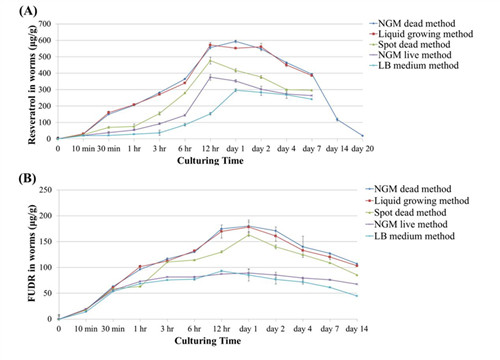Since Caenorhabditis elegans (C. elegans) was chosen as a model organism to study genetics, the worms have been widely used in many research areas, either as research or drug screening model, such as in development, lipid metabolism and obesity, aging, neurodegenerative disease, antimicrobials, virulence and parasites, biomedical and environmental toxicology, and cancer. Treating worms with tool drugs was frequently used in these studies. For the tiny nature of the worms, the drug delivery methods were indirect and often varied from one study to another. The methods of delivering drugs to worms are varied from one study to another, which make difficult in comparing results between studies.
Professor LUO Huairong's group, from Kunming Institute of Botany, has recently evaluated the drug absorption efficiency in C. elegans using five frequently used methods with resveratrol with low aqueous solubility and water-soluble 5-Fluoro-2’-deoxyuridine (FUDR) as positive compounds. They established the best efficiency and economic method to use C. elegans to screen drugs.
The concentration of resveratrol and FUDR increased gradually within C. elegans and reached the highest during 12 hours to one day, and then decreased slowly. At the same time point, the higher the drug concentration, the higher the metabolism rate. The drug concentrations in worms fed with dead bacteria were higher than with live bacteria at the same time point. Consistently, the drug concentration in medium with live bacteria decreased much faster than in medium with dead bacteria, reach to about half of the original concentration within 12 hours.
Resveratrol with low aqueous solubility and water-soluble FUDR have the same absorption and metabolism pattern. The drug metabolism rate in worms was both dosage and time dependent. NGM dead method and liquid growing method achieved the best absorption efficiency in worms. The drug concentration within worms was comparable with that in mice, providing a bridge for dose translation from worms to mammals. Our results might help investigators to choose appropriate drug delivering method to worms.
This work “Drug absorption efficiency in Caenorhbditis elegans delivered by different methods” has been published in PLoS ONE (http://www.plosone.org/article/info%3Adoi%2F10.1371%2Fjournal.pone.0056877)
This research was supported by the Yunnan provincial government (20080A007), the 100 Talents Program of the Chinese Academy of Sciences, and the State Key Laboratory of Phytochemistry and Plant Resources in West China, Kunming Institute of Botany (P2008-ZZ21 and T2009-KF05).

The drug absorption efficiency of worms cultured by using the five methods

The drug catabolism rate in the worms




